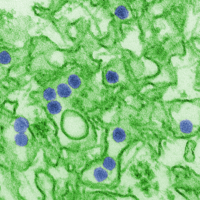
Photo from wikipedia
Introduction Travellers contributed substantially to the rapid spread of Zika virus (ZIKV). They act as sentinel and may unmask ongoing ZIKV transmission in countries where outbreaks have not yet been… Click to show full abstract
Introduction Travellers contributed substantially to the rapid spread of Zika virus (ZIKV). They act as sentinel and may unmask ongoing ZIKV transmission in countries where outbreaks have not yet been reported. Our objectives were to (i) describe the burden of ZIKV infections in international travellers over time; (ii) estimate the proportion of birth defects as a result of maternal ZIKV infection in travellers; (iii) track the extent of sexual transmission; (iv) summarize ZIKV infections in returning travellers as reported by the GeoSentinel network; and (v) identify countries without reports on local ZIKV transmission where travellers served as sentinel. Methods We performed a systematic review from 1947 to April 2017 on travel-associated ZIKV infections. We also compared published reports on autochthonous ZIKV transmission in Asia with published reports on exportations from travellers in Asia. Results Of 314 papers that fit the inclusion criteria, 61 were eligible for final analysis. There was an exponential increase in the number of reported ZIKV infected travellers from the years 2013 to 2016, which declined in 2017. Amongst pregnant women with ZIKV infection, (5%) resulted in a fetus or infant with ZIKV-associated birth defects. An estimated 1% of the total number of ZIKV cases reported in the USA and Europe were acquired through sexual transmission. Through the GeoSentinel network, five countries (Indonesia, Philippines, Thailand, Vietnam, Cameroon) were identified as sentinel markers where ZIKV was exported despite the absence of reported local transmission. Conclusions Mobility patterns and travel volumes can help to identify the most likely origin of importation, and also in predicting further propagation. Studies on pregnant returning travellers have contributed to a better understanding of the risk estimates of congenital Zika syndrome/microcephaly as a result of maternal ZIKV infection, and the relative contribution of sexual transmisison.
Journal Title: Journal of travel medicine
Year Published: 2018
Link to full text (if available)
Share on Social Media: Sign Up to like & get
recommendations!